The University of St Andrews is the oldest university in Scotland, and one of Europe’s most ancient universities. Today, the answer to the question – Why St Andrews? – seems to be rather cliché due to a great importance of St Andrews in the academic world. However, in the first decade of the 15th century it was not that obvious and the subject of consideration of two canon scholars, Bishop Henry Wardlaw in Scotland and Pope Benedict XIII in Avignon, France. Gallery 1, Scotland’s First University, at the Wardlaw Museum presents unique material remnants providing answers to the question Why St Andrews?
Why St Andrews? Bishop Henry Wardlaw’s perspective
While Henry Wardlaw[1] or Henry de Wardlau, who studied canon law at Avignon[2] and was related to the papal court, was granted the bishopric of St Andrews in 1403, this centre of the Scottish medieval Catholic Church was already a burgh with a market town and fairs attracting broad attention. Multiple letters from Benedict XIII to Scotland provide evidence that scholars educated in France were present in St Andrews diocese as early as the late 14th century,[3] however, the local history of studying dates back much further. Scotland’s largest cathedral with a priory was the focal point of the city. [4] For monastic communities, reading was an essential part of spiritual reflection and the library played a significant role in monastic and ecclesiastic life.[5] Books copied from other priories, donated by patrons and benefactors for instance in 1140 and 1150, travelled to St Andrews from other religious houses.[6] This resulted in impressive holdings of works, as described by the authors of the 14th century Registrum Anglie. The St Andrews library was a bedrock of further scholastic community. Two stone book presses,[7] still present in the cloister, are material evidence of what remains from the initial teaching hub. Eight scholars are said to have launched teaching in St Andrews and Bishop Wardlaw describes them in his grant of privileges as ‘venerable men, the doctors, masters, bachelors, and scholars dwelling in the city of St Andrews’.[8] All of these circumstances fuelled the establishment of a studium generale in the years leading up to 1413 when University of St Andrews was founded. [9]
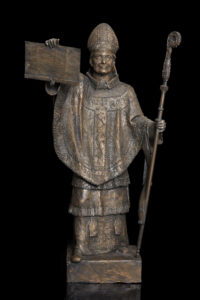
Why St Andrews? Papal perspective
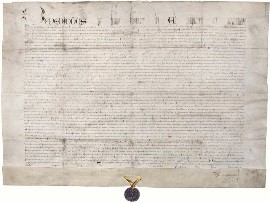
Only the Pope or Emperor could grant both the university status and the licencia ubique docendi; a license to teach anywhere. Bishop Wardlaw and King James I, Wardlaw’s pupil, asked Benedict XIII to authorise the foundation of the university. The papal approval was sent in six bulls granting university status to the institution in St Andrews (1413).
Pope Benedict XIII (1328-1423) was an individual of unique nature in the history of Medieval Europe and the history of the papacy. He was born as Pedro Martínez de Luna y Pérez de Gotor, a son of a noble family in the city of Illueca in Aragon.[10] His Coat of Arms, a crescent moon (luna), along with the diamond shapes of Bishop Wardlaw, and the lion rampant from the Royal Arms of Scotland, formed the Coat of Arms of the University of St Andrews.
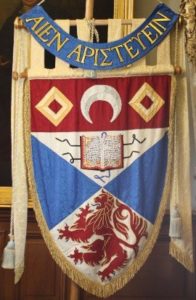
Benedict XIII did not reign in Rome, but in Avignon. As the Antipope, during the Western Schism (1378-1417), he reminded in opposition not only to subsequent popes in Rome (Boniface IX, Innocent VII, Gregory XII) but also to other antipopes derived from the Council of Pisa (1409; Alexander V and John XXIII), and to Martin V, unanimously elected during the Council of Constance (1417). Eventually, as the result of the Council of Constance, Benedict XIII maintained governmental recognition of Armagnac and Scotland only.
Through his claims to the papal throne, Benedict XIII was trying to secure his authority in Europe and the foundation of the university was in his best interest. Bishop Wardlaw even claimed grants of privileges to save the authority of Benedict’s Apostolic See.[11] In the petition to the Pope, Bishop Wardlaw bolsters the case to maintain Scottish loyalty and the threat of heresy by improving local high learning for the clergy.[12] From Benedict’s point of view, the University of St Andrews was to be a lucrative deal strengthening his position against the competitors. Sadly for him, after the Council of Constance, the University of St Andrews decided that support of the council was necessary for a united church and it came out in opposition to Benedict.[13]
A plaster cast of the skull of Benedict XIII and a single hair from his head mounted in a microscope slide[14] remind us that origins of the University are linked with the Great Schism and one of the most influential antipopes.
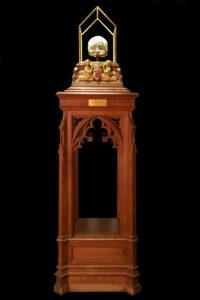
Why St Andrews? Students’ perspective
The answer was explicitly stated in the papal document ‘Because of the dangers and troubles to Scots who, because of the absence of universities in Scotland, have to travel to foreign parts to study’.[16] Another reason was the reduction in the cost of studies. As Norman Reid believes, ‘Scotland needed more clergy who were well educated and the provision of a home university would enable that expansion at a more manageable cost than continuing to send all students abroad (…). Not to stem the flow of Scots to foreign universities – what did not happen – but rather to increase educational provision by offering a home alternative’.[17]
According to Reid, Benedict XIII in his papal bulls acknowledged the education received by Scots at the universities that were not obedient to the antipope. Scottish students returning from universities abroad could continue their studies in St Andrews or pursue their education elsewhere, including universities of schismatic obedience, in this case following the Pope in Rome.[18]
The first students of St Andrews are depicted on the medieval University seal, made between 1414 and 1418, showing scholars learning before a teacher, overseen by Scotland’s patron saint. The University seal was used to authenticate official documents.
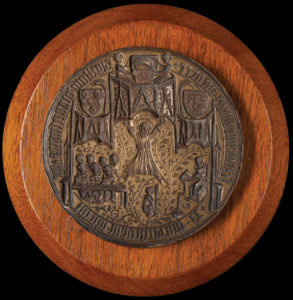
Written by Dr Kamila Oles, Visitor Services Facilitator, Museums of the University of St Andrews
[1] See https://museumoftheuniversityofstandrews.wordpress.com/2018/02/17/who-was-henry-wardlaw/
[2] McGurk F., ed., 1976, Calendar of Papal letters to Scotland of Benedict XIII of Avignon, 1394-1419, Scottish History Society, vol. 13, Edinburgh; Reg Aven 278, 436x-437v, (20 October 1394), p. 20
[3] Ibid. pp.20-23.
[4] Simpson A. and Stevenson S., 1981, Historic St Andrews: the archaeological implications of development, Scottish burgh survey series, Glasgow.
[5] Leedham-Green E., and Webber T, eds., 2006, The Cambridge History of Libraries in Britain and Ireland, vol. 1 , Cambridge; Coates A., 1996, English Medieval Books: The Reading Abbey Collections from Foundation to Dispersal , Oxford.
[6] Duncan A.A.M., The Foundation of St Andrews cathedra Priory, 1140, pp.122-123; Higgitt J., ed., 2006, Scottish Libraries, London 2006, pp. 222-225
[7] Reid N. H., 2017, The Prehistory of the University of St Andrews St. Andrews, in: Brown M., and Stevenson K., eds., Medieval St Andrews. Church, Cult, City, Woodbridge, p. 248.
[8] Ibid. p. 239.
[9] Mason R., 2017, University, City and Society, in: Brown M., and Stevenson K., eds., Medieval St Andrews. Church, Cult, City, Woodbridge, p. 268.
[10] Müller-Schauenburg B., 2019, The lonely antipope – or why we have difficulties classifying Pedro de Luna [Benedict XIII] as a religious individual, in: Fuch M. et al. eds., Religious Individualisation, pp. 1351-1364
[11] The original Wardlaw’s grant of privileges is missing. One of six papal bulls of August 1413, issued for the University of St Andrews, recited Wardlaw’s text; Reid N. H., 2017, The Prehistory of the University of St Andrews St. Andrews, p. 262.
[12] Mason R., 2017, University, City and Society, p. 263.
[13] McGurk F., ed., 1976, Calendar of Papal letters to Scotland of Benedict XIII of Avignon, p. 13.
[14] Read J., 1973, Pedro de Luna: The Pope from the Sea, History Today, vol. 23, issue 3.
[15] https://museumoftheuniversityofstandrews.wordpress.com/2016/12/05/foundations/
[16] McGurk F., ed., 1976, Calendar of Papal letters to Scotland of Benedict XIII of Avignon, 28 August, 1413, Reg Aven 341, 607v-608v, p. 278.
[17] Reid N. H., 2017, The Prehistory of the University of St Andrews St. Andrews, p. 263.
[18] Ibid. p. 246.